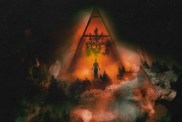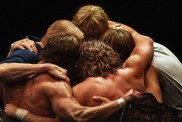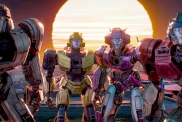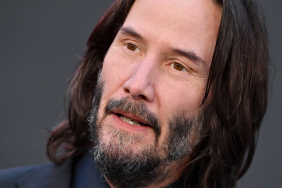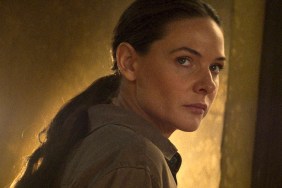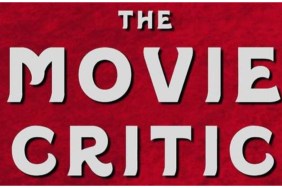With the unexpected success of his 2007 thriller Disturbia, director D.J. Caruso found himself given the keys to the castle by none other than Mr. Steven Spielberg, when Caruso was put in charge of directing a movie based on an idea Spielberg had over ten years ago. The action-packed technological thriller Eagle Eye, Caruso’s fifth film, reunited the director with his Disturbia star Shia LaBeouf.
This time, LaBeouf plays Jerry Shaw, a young slacker who becomes the target of the FBI after a woman’s voice on his cell phone warns him to run; that’s exactly what he does along with a single mother who received a similar command, played by Michelle Monaghan. Together, the two race against time to discover the secret behind the disembodied voice on the phone who seems to be able to access and control the technology around the duo to help their escape.
The movie ended up grossing over $100 million this past fall, and it’s now available on DVD and Blu-ray. ComingSoon.net spoke to Caruso last year for Disturbia, but never got a chance to catch up before the movie’s theatrical release in September, so we wanted to rectify that with an interview for the DVD release, which you can read below. (Coincidentally, this writer had gone to high school at the same time as Caruso just one town over, so we had to catch up on our shared “disturbian” experiences, but that we’ll spare you.)
ComingSoon.net: Congratulations on the movie hitting $100 million, which is a nice bonus.
D.J. Caruso: Yeah, it is definitely, thank you.
CS: Does that mean you get a bigger fruit basket from Steven Spielberg this year?
Caruso: (laughs) All they do is I get a bigger crew jacket next movie, that’s all.
CS: I talked to producers Alex Kurtzman and Roberto Orci, it must have been at the beginning of the summer, and they told me how Steven brought them on board and that they were fans of your work. When did they get you involved? Were you already finished with “Disturbia”?
Caruso: As I was finishing up “Disturbia” and right before that came out, Adam Goodman, who was running production, said, “Steven came up to me and said we have a script for you, it’s not quite ready yet. J.J. Abrams is just finishing a rewrite’cause J.J. did a little address on it, tooand we’d love for you to look at it.” Steven basically just told me quickly that it was an idea that he had many years ago, and he felt that the technology had finally caught up to the storytelling, and this would be the right time to make the movie. That’s basically what I got, and then Alex and Bob, I went down and met them after I read it, because I really liked it and wanted to meet them. I knew who they were but we had never met before. It just felt like we really could work well together, and it all kind of worked out and right now, it’s a lovefest and we all love each other.
CS: It’s always good when the lovefest is still going on after the movie’s done.
Caruso: Yeah, exactly. (laughs) So that’s kind of the genesis of it, and it was one of those you go… Steven had the foresight to come up with the story ten or twelve years ago, and you realize every year that he waited, the story became a little bit more plausible and doable, so I was very fortunate that it came my way.
CS: Before watching the DVD, the “War Games” comparison never dawned on me, so was that one of the things you saw in the script that made you want to do it?
Caruso: When I read it, my first instinct, I swear, I was like, “This could be my ‘War Games.'” I was such a huge fan of “War Games.” I felt like this was a sophisticated “War Games” and that kind of movie for the audiences today and them responding to it, and particularly the fact that the lead character Jerry was so strong and someone that I could relate to. Despite all these outrageous circumstances and the plotting of the trouble they got into, I just loved the character of Jerry, the character whose sort of the guy who had to be the quote-unquote good brother who made himself invisible and removed himself from the competitive nature and then ultimately, having to not win Dad over, but just to show that’s just as much of being a hero and being American is being an individual. Those little themes in the big picture of a fun popcorn movie were something that seemed very enticing to me, and I guess that’s sort of the reason that I said, “I’d love to do this.” I also felt like I’d love to make a movie with this sort of scope and scale and spectacle and action. Being a big fan of seeing those movies, I felt like I was ready to make one like that.
CS: I remembered when we talked about “Disturbia,” you mentioned you wanted to bring the “girl next door” aspect to that movie. Was there anything like that you wanted to bring to this one?
Caruso: What I really pushed here was more Jerry and his father and that relationship, I worked really hard with Alex on that and the undertone of what it’s like to be the one who sort of hides out because you don’t want to be the competitive one with your brother. I read some books on child psychology and siblings that are great and found that to be a very compelling character aspect of Jerry, so I felt like I added that and worked hard at sprinkling that in, then ultimately, making him the guy who had to make the decision what to do. At the end, when he stands there next to his father, his father can be just as proud of him as he is of the brother who went to MIT and did everything right and perhaps created a flawed system that is the reason for this. But there’s a man who had to earn his Dad’s respect back and once he earned his Dad’s respect, he felt good about himself.

CS: I thought the mix of sci-fi with the “French Connection” like action was interesting, as a well as a rather strange mix.
Caruso: Yeah, it’s a strange element but that’s just sort of what just felt right and it was very naturalistic to me. I thought if the world felt very real, that the technology and that the aspect that was science fiction would not feel like a science fiction movie. I think that was probably what got everyone excited about my take on it, was that it was it was interesting because a lot of science fiction movies think they have to set up a science fiction world that’s sort of cold and stagnant and electronic, where I wanted this world to be a very visceral, flesh and blood world, but at the same time, if the technology is being used against youbecause then the audience would be able to relate to these guys in a very realistic way and the technology aspect would then sort of creep its way in and part of the storytelling is that you discover you’re in a science fiction movie about an hour and five minutes into the movie.
CS: How technological are you yourself? Was there stuff that you learned about while you were making the movie?
Caruso: You kind of have your ideas when you read the script and we had a technology expert who was guiding us along and he’d sort of say “This is plausible” and we’d come up with an idea and we’d say “How do we make this happen?” I definitely learned about the technology and the techniques and the equipment and the coded numbers in each phone that has nothing to do with your phone number, that the government has registered these chips with the phone companies and they can trace your phone call at any time and activate your microphone. I got that from reading the script, but it was nice to know that it’s all plausible and part of this was happening in the world. You try to be as accurate as you can so that the reality of the movie remains entertaining and at the same, your bullsh*t detector doesn’t go, “This doesn’t make any sense.” It always has to make sense to the filmmaker.
CS: One of the strange things about the movie is that it has a very high concept but there’s also a major plot twist that I want to ask about, but wanted to make sure it’s okay to talk about it because it’s sort of a major spoiler. (And in case, you haven’t seen it, you might want to skip his response.)
Caruso: It was one of those things that it just sort of evolved in the marketing. I didn’t know how the movie was going to be sold. You never really know that when you’re making a movie. It’s funny when you work on an Amblin/DreamWorks movie, everything starts from being a secret, no matter whether it’s a romantic comedy, so you have this great sort of feeling
your scripts are numbered, you name’s are on your script in a private code, and no one can Xerox it without seeing that it’s your script. You kind of have this great conspiracy thing going all the way along, and Steven was very protective of the “Indiana Jones” plot before and you kind of read about that. We just felt if you knew what was happening in this movie, you would still watch it and be entertained. The twist of the movie is not this gigantic twist that happens at the end in the last two minutes and you go, “Wait a minute
” There’s still an hour in the movie left when you kind of figure out who and what is sort of doing this and who your antagonist is
and then there’s still a plot left. I think the secretive element of it helps you enjoy the movie more because I think part of it is you’re going in with these expectations, like why is this happening and who’s doing it? The who of it, I was happy as a filmmaker that it wasn’t some guy sitting behind the computer twirling his moustache. We kind of took a chance and took the Department of Defense computer one step further. It all kind of evolved about the secrecy of it, but I think it really works for the enjoying of the movie if the question they have going in to watch the movie is still a question they have an hour into it.
CS: When you did “Disturbia,” you obviously built a lot of house interiors, but for this, you built these huge sets and found these amazing locations and combined the two, and I wanted to ask about building the computer and the government building interiors.
Caruso: The scale of the building it was immense in “Eagle Eye.” The trick with “Disturbia” was that we had to figure out a way to make three houses play as one house. You would look out one window in “Disturbia” and be in a city called Whittier, the next house, the back of the house would be in Pasadena, and then ultimately, the third house would be the set on Paramount’s lot, but when you see the movie, you’d never know that. “Eagle Eye” had big, gigantic sets that we had to have some computer extensions and all these other things. For me, there’s this facility called Playa Vista, which is downtown in Playa Vista off Marina del Rey, and basically, I’ve never had a movie big enough to use them, but I’ve always heard about people who are going down to Playa Vista and finally when we started scouting, I realized, “Okay, I’m a big movie,” because we had to build all these sets in Playa Vista. And building the House floor was like when I knew, “Holy sh*t, this is a pretty big movie.” Because when you went on that set and the first day that we had that set, there were 800 extras on the House floor, and it was such a perfect replica. Everyone would come and take photographs and it would take your breath away and then we saw the State of the Union address, and I remember sitting there with my kids and we all looked at each other and they went, “Wow, Dad, we’ve already been to that place.”

CS: I remember you mentioning having to match the different sets in “Disturbia” but here you were mixing outdoor locations with big set pieces, like the tunnel.
Caruso: That’s always fun as a filmmaker because “Disturbia” is a very small movie, but at the same time, there’s so many great tricks that were done, old-fashioned tricks, that enabled us to pull that off, and it’s great that viewers will never know that. I also think it takes that the studio has faith in me to understand that we’re using these three different locations to kind of gel and make one. That’s what’s always fun about it.
CS: You seem to work with different people and crews for your movies, which I find surprising, since most directors find a team and stick with them.
Caruso: I’m a very collaborative director but I also have a very strong eye. I think that choosing a DP is very important to me, and the ones that I’ve worked with, I’ve had very good experiences with. Sometimes, it’s just a matter of timing and not being in sync. Dariusz Wolski, who shot this one, is so fantastic and I would work with him again in a second if I could ever get him again, but he never stops working. A lot of what happens with the crew as a filmmaker is that I’ve been fortunate to make five movies in maybe seven years, but a lot of times a filmmaker doesn’t make that many films and he falls out of sync with his crew. Or if you make very few, then the crew is always trying to get back with you and wait for you to make your movie, but they have to make their living moreso by not stopping the work. We sometimes have the luxury of making a movie, then taking three or four months to find another movie before you start again, so you fall out of sync. I have a dream crew that I would put on paper and say, “This is exactly everybody I’ve worked with that I love and want to work with again” but the chances of getting that crew together in full would be very slim.
CS: I want to ask about doing the stunts as well. I remember you had a car chase in “Taking Lives,” and there was some action on “The Shield.” How did you convince Steven and the rest of the studio that you could do these really huge action set pieces which I assumed were in the script?
Caruso: Yeah, I think what happens is that I have a 2nd Unit background, having come up with John Badham, so I got a little taste of the 2nd Unit and the puzzle-making, but I think that’s why I wanted to do this movie was because I knew that I could make a movie like this. I thought that if I could bring my style of filmmaking into this sort of genre with the big set pieces and the action and still maintain my character credibility. I just thought that was one of the big reasons for taking a movie like this, because it was exactly what you wouldn’t think I could do.
CS: Did you know at any time while you were shooting that it was going to be shown in IMAX or was that a later decision?
Caruso: No, we were more of an IMAX afterthoughtI mean that in a good way. They saw the movie and thought, “Wow, this would be a great fall movie. We don’t really have a good fall action movie,” and so I felt that was great. Had I known, I would have taken a page from Christopher Nolan, whose a genius and maybe done a sequence or two in IMAX, and I know that “Transformers” is going to do that now and “Iron Man” is doing that, so it’s become sort of the thing. What I liked about it was that it sort of solidified, “Wow, I actually made an event movie” because I think “The Dark Knight” made the IMAX Experience almost a lust for people. It brands your movie as “Okay, this is an event movie if you’re an IMAX movie” and getting to see that whole process and remix the movie for IMAX because their sound system is slightly different and get a big 70mm print and work on the digital version that was in 15 theaters. It was a really really good experience for me as a filmmaker to take that all the way through the final steps, too.
CS: Have you thought at all about making another movie where you can either take advantage of IMAX or the new 3D technology in the future?
Caruso: Yeah, I think I’m open to it, to have the right project. I’m not sure how I feel about 3D right now. In fact, Dariusz Wolski, who’s now working with Tim Burton again, I know they were doing “Alice in Wonderland” and I know it’s in 3D and I think they eventually decided to scrap the 3D cameras and to do the 3D element in post now. I don’t know. I think if it’s the right movie and the thing feels right than I would explore those avenues.
CS: Was it your idea to have the sit-down with John Badham for the DVD extras on “Eagle Eye”? I loved that.
Caruso: Yeah, because I think the DVD producer heard me talk about “War Games” a lot and how that was a movie that sort of inspired me. They made the connection and they suggested that, and I thought it was a great idea.
CS: I just remember that coming out the summer that I graduated and he had that and “Blue Thunder.”
Caruso: Yeah, it was ’83. He had a great summer; he had “Blue Thunder” and “War Games” and was that the “E.T.” year, too?
CS: It might have been.
Caruso: Yeah, life was a lot simpler then than it is now.

CS: You can say that again. I do want to ask about “Y: The Last Man,” which I know you talked about in September and you mentioned you’re still working on the script. I talked to David Goyer maybe three or four years ago, and it’s been a while in development.
Caruso: Yeah, it’s been a while. I think it’s one of those that the source material is fantastic stuff, it’s great, but it’s a tough one to lick into getting into a screenplay. I’ve tried to feel like it’s a trilogy of movies and I think everyone sort of agrees, but at the same time, just getting the first movie right and getting the right beats and knowing what to put in, it’s been really tough. You have great minds like David Goyer and you’ve got Carl Ellsworth and you’ve got Brian K. Vaughn, and I’m working with them to just kind of crack it and get it down. And we’re almost there. I know it’s a slow process, but I think eventually we’ll get it. We’re going to get it and we’ll get it right, but we had a pretty good breakthrough a couple weeks ago in the final act, and hopefully we’ll get there.
CS: I was really curious about the trilogy aspect because when you make a movie, you’ll want to make sure that the first movie has a suitable ending, or else you end up like “The Golden Compass,” where if you leave a movie open-ended…
Caruso: Yeah, and this movie, I don’t think the movie so much will be left open-ended, it’s just a matter of, if you’re familiar with the source material, there’s so much great stuff and he meets so many great characters but it’s over the course of a long period of time. When you’re telling the storyyes, the fanboys and all the people who love it will go and see itbut if you’re just seeing the movie from a filmgoers’ perspective and you’re not familiar with the source material, you have to make sure you make the movie that they understand and they love, too. Like I said, it’s been more difficult than I thought but we’re getting close.
CS: One good thing is that since the comic series is over, you at least know where the story goes. Are you at least trying to have some sort of outline for the other two movies while you’re writing the first one?
Caruso: No, we’re not really outlining but you know, it’s nice when you know where it ends. It actually thematically helps you as a filmmaker and a storyteller, if you then treat it as one piece of work then you kind of know where you end and what the theme of the piece is now. It really helped with seeing closure and what is this all about? I thought the ending was really good and really compelling, but if you take the first movie and then you (put) Yorick into that ending, I think then it doesn’t feel like you can accomplish that in one movie. You can’t accomplish in that one movie.
CS: Do you think this might be your next movie or do you think you’ll try to make another movie in between?
Caruso: Well, you know, I think we’ll probably do one in between if we don’t get the script going soon, but we’ll see. I have not found a movie that’s there yet. I just think if we turn in “Y” after the holiday and it came in and got going quick then it would be up for sure. I’m open to it, but I need to eventually make a living.
CS: I also wanted to ask about the possibility of doing more TV stuff. Obviously, Alex and Bob came from that background and have been working in television for a long time, so have you thought at all about developing some of your own television projects?
Caruso: Yeah, in fact I’m working on that now. There’s been this idea that’s been banging around my head for a while, and I’m meeting with a couple writers. I have a pretty strong TV background, and I think people are interested in hearing what I have to say, and if I can help create a series and launch it and then direct the pilot and give it sort of its signature and nurture it, in the perfect world, that would be great. But there’s a couple things, particularly one idea that would kind of work, and we’ll see what happens. It’s definitely an area of interest for me. I love the immediacy of television, because you get something done and you get it down, and people are like, “Alright, let’s go make it” and you go make it. You don’t know how long it’s going to air, how long it’s going to last, but unlike the film development process which tends to be very slow, I love the immediacy of television.
Eagle Eye is now out on DVD and Blu-ray. Check out ComingSoon.net’s review and you can order the 2-Disc Special Edition or Blu-ray Disc from Amazon.
